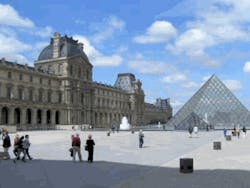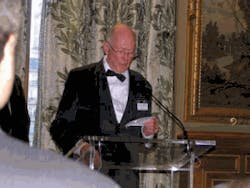Nobel Laureates, pioneers celebrate lasers in the City of Light
Paris, France--It was truly an honor to attend "50 Years of the Laser in the City of Light" from June 21-23 in Paris--one of the worldwide events of 2010 celebrating the 50th anniversary of the laser. Organized by the Institut de la Lumière Extrême or Extreme Light Institute (ELI) at ENSTA and chaired by Gérard Mourou, École Polytechnique professor and ELI director, the three-day event brought around 600 laser industry professionals and a nearly equivalent number of students and lay people to Paris, France to celebrate the laser by reliving its history, describing its broad role in current applications, and foretelling its promising future. For details on the event, go to www.laser50paris.com.
Nobel inspiration
On day one of the Paris celebration (June 21), 70 or so attendees and presenters were treated to an afternoon tour of the Louvre museum, "The best museum in the world in the best city in the world" in the words of Gérard Mourou. The Louvre would also be the site for a later-that-afternoon presentation by Costas Fotakis, University of Crete professor and director of the Institute of Electronic Structure and Laser (IESL) at FORTH, the Foundation for Research and Technology - Hellas (both in Crete, Greece), on laser science in the preservation of cultural heritage, as well as the site for the full-day technical sessions on June 22, day two of the event.
After dividing into four different tour groups, we headed into the glass pyramid entrance of the Louvre amidst noisy crowds and warm, humid conditions. And there, usually ahead of the rest of us, was 95-year-old Nobel Laureate Charles H. Townes, as fascinated and eager to see the “Masterpieces of the Louvre” such as Venus de Milo, the Winged Victory (Nike) of Samothrace, and of course Mona Lisa (swamped by some fraction of her eight million visitors each year), as the rest of us. It was easy to see how Townes’ enthusiasm brought him to discover the MASER (microwave amplification by stimulated emission of radiation) and write, with Arthur Schawlow, a 1958 paper on microwave amplification that set the foundation for the eventual demonstration of the optical MASER or LASER (light amplification by stimulated emission of radiation) by Ted Maiman at Hughes Research Laboratories (Malibu, CA) on May 16, 1960.
Watching Townes during the Louvre tour was inspirational enough; but as I would learn later in his presentations that would follow over the next two days, just a typical indication of his willingness to keep learning and exploring--a trait he found to be invaluable as a laser scientist in those early years of discovery.
In addition to Charles Townes, who received the 1964 Nobel Prize in Physics (jointly with Nicolay Gennadiyevich Basov and Aleksandr Mikhailovich Prokhorov) for MASER principles, five other Nobel Laureates attended and/or presented at the event: Nicolaas Bloembergen (one half of the 1981 Nobel Prize in Physics shared by Arthur L. Schawlow for laser spectroscopy); Claude-Cohen Tannoudji (1997 Nobel Prize in Physics shared jointly with Stephen Chu and William D. Phillips for methods to cool and trap atoms with lasers); Ahmed H. Zewail (1999 Nobel Prize in Chemistry for femtosecond spectroscopy studies); Herbert Kroemer (one half of the 2000 Nobel Prize in Physics shared by Zhores I. Alferov for developing semiconductor heterostructures); and Charles Kao (one half of the 2009 Nobel Prize in Physics for achievements in fibers for optical communications). And even Ted Maiman was there in spirit as his wife Kathleen Maiman presented "The Discovery of the First Laser" on Tuesday morning. As I was about to learn from Mrs. Maiman and from all the Nobel Laureates and laser pioneers giving presentations at the event, the development of the laser was not straightforward; the path was filled with its share of naysayers and skeptics who said, "It couldn't be done" with surprising regularity. But lucky for society and the average consumer who benefits from the laser in countless ways everyday, the Nobel Laureates were stubborn and ignored the warning.
Recalling those early days
In Gérard Mourou's introduction to the day two audience (somewhere under the antiquities of the Louvre), he likened the laser to 'domesticated' light, as if a confused barbaric horde, to paraphrase, was converted to a disciplined, in-step army.
And the discipline began with the MASER, as Charles Townes would recount in "Origin of the Laser," the first of 11 presentations held that day, 22 June. Townes developed the MASER with brother-in-law Arthur Schawlow and described how it was truly an industrially driven invention; even the Russians were in the game, he said. When Bell Labs wouldn't patent the MASER, Townes said that Schawlow had to tell them how it could possibly be used in an optical communications application and wrote a paper on the ‘optical maser.’ Townes said that even Niels Bohr didn’t think the laser would work. Even though the idea was known in the 1920s, "No one sort of believed it, especially the physicists," said Townes. And so came the challenge, the willingness to be open-minded, take risks, and exchange ideas and develop partnerships with people who could both question and complement your work. Townes was also quick to point out that accidents played an important role as well.Townes’ message of perseverance was echoed by Kathleen Maiman, who called her husband a ‘maverick’ and a ‘contrarian,’ challenged by those who speculated a laser wasn’t possible. Maiman’s simplistic design of a few-pound flash-lamp-pumped ruby rod was built with a $50,000 project budget, "The best research bargain of all time" enjoyed by Hughes Research Labs, she said. Maiman’s paper on the laser wasn’t the first to be rejected by Physical Review Letters; it was published by Nature. But to Ted’s disappointment, said Kathleen, news reports from his New York press release would read, "LA man invents death ray." Ted Maiman’s autobiography Laser Odyssey tells the whole story.
Laser technology has grown from those early inventions into applications as diverse as bar-code readers, automobile welders, CD and DVD sources, enabling Bose-Einstein condensates, to chirp-pulse amplification techniques (thanks to Gérard Mourou) that make petawatt-and-higher class lasers possible (and potentially enabling the realization of efficient fusion energy).
Tuesday afternoon sessions kicked off with "Seeing in 4 Dimensions from Cats to Atoms," from Nobel Laureate Ahmed H. Zewail, Linus Pauling Chair professor of chemistry and professor of physics at the California Institute of Technology (Caltech; Pasadena, CA), who described how lasers are assisting transmission electron microscopy (TEM) by adding the fourth dimension—time—to already groundbreaking ultrafast molecular studies. Can studies of protein unfolding reveal the mechanisms of Alzheimer’s disease? Can 4D microscopy compete with chromophores in biological studies? Zewail says yes, thanks to the laser.
The sky's [not] the limit
After a reception on Tuesday evening at the famed l’Hôtel de Ville in Paris, complete with champagne, appetizers, and a laser light show, day three of "50 Years of the Laser in the City of Light" moved to a larger, more academic venue at École Polytechnique in Palaiseau, just 30 minutes by train from Paris. Geared for the large student population attending the event, several French companies and institutes had exhibit booths demonstrating current laser technologies and active applications.
Starting with Nobel Laureate Nicolaas Bloembergen, honorary faculty member in the College of Optical Sciences at the University of Arizona (Tucson, AZ), discussing "High Field Science" and ending with John H. Nuckolls, director emeritus of Lawrence Livermore National Laboratory (Livermore, CA), presenting "Laser Inertial Fusion Energy," the presentations implied no limit to what the laser can do, either at very small scales (ultrafast and attosecond dynamics), to the generation of fusion energy, to guide-star applications on the largest of scales, outer space.
Many of the presentations on Wednesday were mini tutorials, with graphics of Snell’s law, linear and nonlinear reflection/refraction scenarios, and discussions of second harmonic generation mechanisms and laser-driven particle acceleration. Among the presentations was "Heterostructure Lasers: how it all got started" from Nobel Laureate Herbert Kroemer, University of California at Santa Barbara (UCSB). As with Maiman’s early paper, Kroemer’s paper on the first heterostructure laser was rejected by Applied Physics Letters also, but published by the IEEE. The corporate verdict on those early semiconductor lasers, said Kroemer, was "This device will never have any practical applications." Patented in 1963, the patent expired before Kroemer could benefit financially from it--a common story amongst the early laser scientists.
Despite the many practical laser applications that have emerged, laser scientists are still asking the fundamental questions that Einstein asked a century ago: Is light a particle or a wave? Alain Aspect, professor at Institut d’Optique and École Polytechnique and CNRS scientist, presented "From Einstein to Wheeler: wave-particle duality brought to light." Believe it or not, the advent of single-photon sources and detectors is yielding new insight into this very old conundrum. Somehow, and I’m still baffled by it, a single photon interferes with itself as if it were a wave [or did I just not understand the presentation?]. I obviously need to go back to Physics 101.
Closing out the afternoon sessions was Sigrid Avrillier from the Laboratoire de Physique des lasers on "Lasers and Medicine" and finally, Nuckolls on laser fusion. We are all seeing the power of lasers in medicine with LASIK surgery and aesthetic processes, but here’s hoping the naysayers for laser fusion energy are just as wrong today as they’ve proven to be throughout the laser’s history.
RESOURCE: 50th anniversary laser celebrations for the remainder of 2010 include Laser Optics 2010 (June 28 - July 2 in St. Petersburg, Russia; www.laseroptics.ru); see the full calendar of events at http://laserfest.org/events/index.cfm.

Gail Overton | Senior Editor (2004-2020)
Gail has more than 30 years of engineering, marketing, product management, and editorial experience in the photonics and optical communications industry. Before joining the staff at Laser Focus World in 2004, she held many product management and product marketing roles in the fiber-optics industry, most notably at Hughes (El Segundo, CA), GTE Labs (Waltham, MA), Corning (Corning, NY), Photon Kinetics (Beaverton, OR), and Newport Corporation (Irvine, CA). During her marketing career, Gail published articles in WDM Solutions and Sensors magazine and traveled internationally to conduct product and sales training. Gail received her BS degree in physics, with an emphasis in optics, from San Diego State University in San Diego, CA in May 1986.

